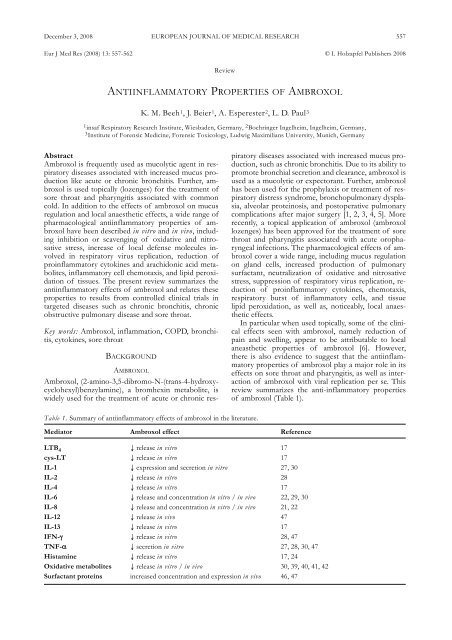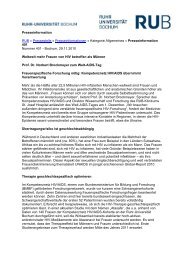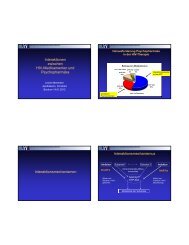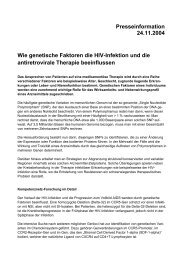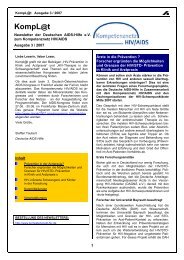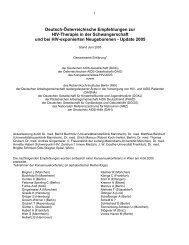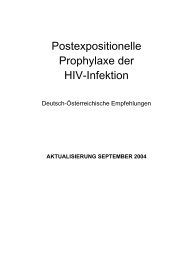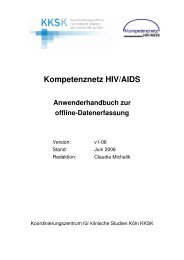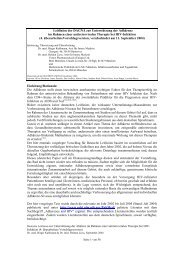K. M. Beeh, J. Beier, A. Esperester, L. D. Paul - Kompetenznetz HIV ...
K. M. Beeh, J. Beier, A. Esperester, L. D. Paul - Kompetenznetz HIV ...
K. M. Beeh, J. Beier, A. Esperester, L. D. Paul - Kompetenznetz HIV ...
You also want an ePaper? Increase the reach of your titles
YUMPU automatically turns print PDFs into web optimized ePapers that Google loves.
December 3, 2008<br />
Abstract<br />
Ambroxol is frequently used as mucolytic agent in respiratory<br />
diseases associated with increased mucus production<br />
like acute or chronic bronchitis. Further, ambroxol<br />
is used topically (lozenges) for the treatment of<br />
sore throat and pharyngitis associated with common<br />
cold. In addition to the effects of ambroxol on mucus<br />
regulation and local anaesthetic effects, a wide range of<br />
pharmacological antiinflammatory properties of ambroxol<br />
have been described in vitro and in vivo, including<br />
inhibition or scavenging of oxidative and nitro -<br />
sative stress, increase of local defense molecules involved<br />
in respiratory virus replication, reduction of<br />
proinflammatory cytokines and arachidonic acid meta -<br />
bolites, inflammatory cell chemotaxis, and lipid peroxidation<br />
of tissues. The present review summarizes the<br />
antiinflammatory effects of ambroxol and relates these<br />
properties to results from controlled clinical trials in<br />
targeted diseases such as chronic bronchitis, chronic<br />
obstructive pulmonary disease and sore throat.<br />
Key words: Ambroxol, inflammation, COPD, bronchitis,<br />
cytokines, sore throat<br />
BACKGROUND<br />
AMBROXOL<br />
Ambroxol, (2-amino-3,5-dibromo-N-(trans-4-hydroxycyclohexyl)benzylamine),<br />
a bromhexin metabolite, is<br />
widely used for the treatment of acute or chronic res-<br />
EU RO PE AN JOUR NAL OF MED I CAL RE SEARCH 557<br />
Eur J Med Res (2008) 13: 557-562 © I. Holzapfel Publishers 2008<br />
Review<br />
ANTIINFLAMMATORY PROPERTIES OF AMBROXOL<br />
K. M. <strong>Beeh</strong> 1, J. <strong>Beier</strong> 1, A. <strong>Esperester</strong> 2, L. D. <strong>Paul</strong> 3<br />
1 insaf Respiratory Research Institute, Wiesbaden, Germany, 2 Boehringer Ingelheim, Ingelheim, Germany,<br />
3 Institute of Forensic Medicine, Forensic Toxicology, Ludwig Maximilians University, Munich, Germany<br />
Table 1. Summary of antiinflammatory effects of ambroxol in the literature.<br />
Mediator Ambroxol effect Reference<br />
piratory diseases associated with increased mucus production,<br />
such as chronic bronchitis. Due to its ability to<br />
pro mote bronchial secretion and clearance, ambroxol is<br />
used as a mucolytic or expectorant. Further, ambroxol<br />
has been used for the prophylaxis or treatment of respiratory<br />
distress syndrome, bronchopulmonary dysplasia,<br />
alveolar proteinosis, and postoperative pulmonary<br />
complications after major surgery [1, 2, 3, 4, 5]. More<br />
recently, a topical application of ambroxol (ambroxol<br />
lozenges) has been approved for the treatment of sore<br />
throat and pharyngitis associated with acute oropharyngeal<br />
infections. The pharmacological effects of ambroxol<br />
cover a wide range, including mucus regulation<br />
on gland cells, increased production of pulmonary<br />
surfactant, neutralization of oxidative and nitrosative<br />
stress, suppression of respiratory virus replication, reduction<br />
of proinflammatory cytokines, chemotaxis,<br />
respiratory burst of inflammatory cells, and tissue<br />
lipid peroxidation, as well as, noticeably, local anaesthetic<br />
effects.<br />
In particular when used topically, some of the clinical<br />
effects seen with ambroxol, namely reduction of<br />
pain and swelling, appear to be attributable to local<br />
aneasthetic properties of ambroxol [6]. However,<br />
there is also evidence to suggest that the antiinflammatory<br />
properties of ambroxol play a major role in its<br />
effects on sore throat and pharyngitis, as well as interaction<br />
of ambroxol with viral replication per se. This<br />
review summarizes the anti-inflammatory properties<br />
of ambroxol (Table 1).<br />
LTB 4 ↓ release in vitro 17<br />
cys-LT ↓ release in vitro 17<br />
IL-1 ↓ expression and secretion in vitro 27, 30<br />
IL-2 ↓ release in vitro 28<br />
IL-4 ↓ release in vitro 17<br />
IL-6 ↓ release and concentration in vitro / in vivo 22, 29, 30<br />
IL-8 ↓ release and concentration in vitro / in vivo 21, 22<br />
IL-12 ↓ release in vivo 47<br />
IL-13 ↓ release in vitro 17<br />
IFN-γ ↓ release in vitro 28, 47<br />
TNF-α ↓ secretion in vitro 27, 28, 30, 47<br />
Histamine ↓ release in vitro 17, 24<br />
Oxidative metabolites ↓ release in vitro / in vivo 30, 39, 40, 41, 42<br />
Surfactant proteins increased concentration and expression in vivo 46, 47
558 EUROPEAN JOURNAL OF MEDICAL RESEARCH<br />
December 3, 2008<br />
ANTIINFLAMMATORY EFFECTS OF AMBROXOL<br />
Inflammation is generally defined as a distinct response<br />
of the immune system to noxious stimuli. Recruitment<br />
of inflammatory cells involves a series of<br />
regulated events including chemotactic stimuli like cytokines<br />
or lipid mediators, transendothelial migration<br />
of leukocytes through selectin-mediated tethering,<br />
rolling and subsequent adhesion by integrin-dependent<br />
mechanisms [7, 8]. At the respective site of inflammation,<br />
inflammatory cells become activated<br />
through multiple stimuli, which lead to release of proteolytic<br />
enzymes, cytokines, nitric oxide and superoxide<br />
anion. In inflamed tissues, clearing of inflammatory<br />
cells may also be delayed by survival-promoting factors,<br />
such as granulocyte-macrophage colony stimulating<br />
factor [9] or leukotrienes.<br />
While the physiological role of the inflammatory<br />
response is generally to eliminate potential noxious<br />
agents or stimuli, the cellular response itself may act as<br />
a stimulus for inflammation to persist, thus forming a<br />
vicious cycle in such chronic inflammatory diseases,<br />
even after the initial trigger has been eliminated. However,<br />
this phenomenon may also be observed in acute<br />
disease states such as the systemic inflammatory response<br />
syndrome (SIRS) or acute rhinovirus infection,<br />
where it has been shown that not infection or viral cytotoxicity<br />
per se, but rather the inflammatory response<br />
to viral infection causes the majority of tissue damage<br />
and – consecutively – symptoms [10]. Numerous studies<br />
have evaluated the effect of ambroxol on inflammatory<br />
mechanisms, and these involve initiation, amplification<br />
and persistence of inflammation.<br />
EFFECTS OF AMBROXOL ON CHEMOATTRACTANTS<br />
In acute inflammation, chemoattractants and/or cytokines<br />
with chemoattractant properties are the primary<br />
initiators of an inflammatory response. Among the<br />
various chemoattractants, the lipid mediator<br />
leukotriene (LT) B 4 is one of the most potent and important<br />
chemoattractants in acute responses, such as<br />
viral infections. LTB 4 exerts its main effects on monocytes<br />
/ macrophages and neutrophils, which are key<br />
players in the initiation of various acute inflammatory<br />
diseases [11]. After binding to its neutrophil receptor,<br />
LTB 4 elicits calcium influx, transmembrane potential<br />
changes, degranulation, increased expression of the<br />
CD11b/CD18 adhesion molecule and, as a result,<br />
chemotaxis. In many chronic inflammatory diseases<br />
there is evidence of CD11b/CD18 upregulation on<br />
neutrophils together with increased levels of LTB 4 in<br />
serum or respiratory secretions [12, 13]. For example<br />
in COPD, LTB 4 accounts for a large part of the total<br />
neutrophil chemotactic activity of airway secretions<br />
[14, 15]. Interestingly, LTB 4 also inhibits neutrophil<br />
apoptosis which may delay the resolution of inflammation<br />
in tissues [16]. Epithelial cells, but also inflammatory<br />
cells like mast cells, basophils, eosinophils,<br />
macrophages/monocytes, and neutrophils themselves<br />
represent a major source of LTB 4. In models of acute<br />
inflammation, ambroxol effectively reduced the release<br />
of LTB 4 from monocytes and neutrophils after stimulation<br />
[17]. Further in this regard, Stockley et al. have<br />
shown that ambroxol at therapeutic concentrations inhibits<br />
the neutrophil chemotactic response to various<br />
chemoattractants [18].<br />
Alongside LTB 4, interleukin (IL) -8, a CXC-chemo -<br />
kine, has potent neutrophil and macrophage chemoattractant<br />
activities [8, 19]. IL-8 is consistently associated<br />
with, in particular neutrophil dominated, inflammation,<br />
and IL-8 concentrations in tissues, blood or other<br />
biological samples are often directly correlated with<br />
neutrophilia. Epithelial cells and macrophages are major<br />
sources of IL-8, and IL-8 is released following a<br />
number of inflammatory stimuli [20]. The release of<br />
IL-8 from bronchial epithelial cells was reduced after<br />
pre treatment of cells with ambroxol [21]. A further<br />
investigation in subjects with COPD showed that<br />
blood and salivary IL-8 was reduced after 10 days<br />
treatment with ambroxol [22].<br />
In addition to neutrophils and monocytes, other effector<br />
cells play an important role in certain types of<br />
inflammation, e.g. basophils and eosinophils in allergic<br />
conditions. These cells are particularily responsive to<br />
T(helper)2 or mast-cell derived chemoattractant cytokines<br />
like IL-4, IL-13, or IL-5, and chemotactic mediators<br />
like cysteinyl leukotrienes or vasoactive peptides<br />
(e.g. histamines) [23]. In a study by Gibbs et al.,<br />
ambroxol reduced both basophil release of cysleukotrienes,<br />
IL-4, IL-13 and histamine, while also decreasing<br />
mast cell release of histamine in human skin<br />
mast cells 17.Mast cell release of histamine was also<br />
reduced by ambroxol in a different study using human<br />
adenoids [24].<br />
EFFECTS OF AMBROXOL ON CYTOKINES<br />
In addition to chemotaxis, the initiation of the inflammatory<br />
cascade is mediated by a sequence of signalling<br />
events directing effector cells into sites of inflammation.<br />
Leukocytes tethering, rolling and transmigration<br />
along endothelial walls of blood vessels is mediated by<br />
cell adhesion molecules [25], and their expression is<br />
among other mechanisms induced by classical proinflammatory<br />
cytokines like IL-1β, IL-4, IL-6, IL-13 or<br />
tumor necrosis factor (TNF) [26]. The release or production<br />
of some of these cytokines has been shown<br />
to be reduced by ambroxol.<br />
Bianchi et al. demonstrated a significant reduction<br />
of IL-1 secretion from lipopolysaccharide (LPS)-treated<br />
human macrophages in vitro by ambroxol [27]. In<br />
their study, it was also shown that ambroxol significantly<br />
inhibited IL-1β mRNA expression, indicating<br />
an effect not only on cytokine release, but also production.<br />
Similar effects were observed by Pfeifer et al.<br />
who investigated the effects of ambroxol on IL-2 release<br />
from human bronchoalveolar lavage (BAL) and<br />
peripheral blood mononuclear cells [28]. In addition<br />
to IL-2, interferon (IFN)-γ release was also reduced by<br />
ambroxol, indicating a more general antiinflammatory<br />
effect of ambroxol on T-cells.<br />
In a rat model of LPS-induced acute lung injury,<br />
ambroxol also potently reduced proinflammatory cytokines<br />
IL-6 and TNF-alpha compared to saline-treated<br />
animals [29]. In this study, the inhibitory effect of<br />
ambroxol was comparable to dexamethasone. Salivary<br />
levels of IL-6 were also significantly reduced by am-
December 3, 2008 EUROPEAN JOURNAL OF MEDICAL RESEARCH<br />
559<br />
broxol treatment in COPD patients after 10 days 22.<br />
Jang et al. [30] reported that ambroxol decreased the<br />
production of IL-1β, IL-6, and TNF-alpha in alveolar<br />
macrophages activated by LPS, while also reducing the<br />
production of superoxide anion, hydrogen peroxide,<br />
and nitric oxide and the release of cellular granular enzymes<br />
like lysozyme.<br />
TNF-alpha, besides its general function as proinflammatory<br />
cytokine, also promotes the chemotactic<br />
response of inflammatory cells to chemoattractants in<br />
various ways [19]. Therefore, it seems noticeable in<br />
this regard, that Bianchi et al. demonstrated an in vitro<br />
suppression of approximately 90% by ambroxol on<br />
the production of TNF from human macrophages after<br />
stimulation with lipopolysaccharide (LPS) [27].<br />
TNF production by BAL cells and peripheral blood<br />
mononuclear cells PBMCs was also significantly reduced<br />
by ambroxol in another study by Pfeifer et al.<br />
[28].<br />
Finally, Aihara et al. studied the effect of ambroxol<br />
on LPS-induced secretion of IL-12 and IL-10 by human<br />
alveolar macrophages [31]. In particular, they investigated<br />
the ratio of IL-12/IL-10, since it is assumed<br />
that the particular ratio of these cytokines regulates<br />
T-cell responses rather than their mere concentrations<br />
per se. In their study, ambroxol increased the<br />
secretion of IL-12, but not IL-10, thus shifting the IL-<br />
12/IL-10 ratio in favour of IL-12. This observation<br />
would indicate a possible role of ambroxol in enhancement<br />
of T-cell mediated immunity. However,<br />
one needs to take into account that macrophage-derived<br />
TNF negatively regulates IL-12 secretion of<br />
macrophages, thus the observed increase of IL-12 secretion<br />
could also be a direct consequence of the previously<br />
described inhibitory effect of ambroxol on<br />
TNF-secretion.<br />
The mechanisms by which ambroxol elicits antiinflammatory<br />
effects on release and production of various<br />
cytokines are as yet incompletely understood. One<br />
possible explanation is a direct inhibition of phosphodiesterases<br />
(PDE), including PDE-4, by ambroxol, as<br />
reported by Ferretti et al. [32]. Moreover, ambroxol<br />
could also interact with the transcription factor NFkappa<br />
B, thus reducing intracellular production of<br />
proinflammatory cytokines [21]. Finally, Kim et al. observed<br />
an inhibition of cellular activation processes involving<br />
proteine kinase C and protein tyrosine kinases<br />
by ambroxol [33].<br />
OXIDATIVE AND NITROSATIVE STRESS<br />
Oxidative stress results from the increased presence<br />
and activation of inflammatory cells, in particular neutrophils,<br />
which generate vast amounts of reactive oxygen<br />
intermediates as part of their innate antibacterial<br />
defense. Several cellular and non-cellular defense<br />
mechanisms protect resident cells from injury due to<br />
oxidative stress. However, in chronic inflammatory<br />
conditions, there is ample evidence that endogenous<br />
defense mechanisms are insufficient to counteract oxidative<br />
injury [34-37]. Inflammatory cell-derived oxidants<br />
can also interact with other cellular mediators to<br />
enhance their cytotoxic effects. For example, neutrophil-derived<br />
myeloperoxidase (MPO) and hydrogen<br />
peroxide (H 2O 2) promote both epithelial and par -<br />
enchymal tissue damage through formation of toxic<br />
hypochlorous acides (HClO), activation and increased<br />
release of cytokines [38]. Further, the interaction of<br />
reactive oxygen intermediates with nitric oxide (NO)<br />
metabolites generated by NO-synthases (NOS), which<br />
are activated or induced by proinflammatory cytokines,<br />
promotes the formation of highly reactive nitrogen<br />
species, in particular peroxynitrite (ONOO-).<br />
Therefore, the restoration of the oxidant/antioxidant<br />
imbalance and counteraction of nitrosative stress has<br />
been a desirable therapeutic option in various chronic<br />
inflammatory diseases.<br />
Ambroxol has been shown to have beneficial therapeutic<br />
effects on markers of oxidative stress in a number<br />
of investigations. Gillisen et al. showed that ambroxol<br />
at therapeutic concentrations reduced the release<br />
of reactive oxygen species (ROS) by polymorphonuclear<br />
cells in a time-dependent manner, suggesting<br />
that ambroxol did not only have the potential to<br />
directly scavenge free radicals, but also alter the prooxidative<br />
metabolism in inflammatory cells [39]. Further,<br />
Stetinova et al. demonstrated that ambroxol inhibited<br />
hyaluronic acid degradation induced by hydroxy radicals<br />
and lipid peroxidation by hydroperoxide both in<br />
vitro and in vivo [40]. Ambroxol also inhibited peroxynitrite-<br />
and hypochlorous acid induced damage of alpha-1—antiproteinase,<br />
an important endogenous inactivator<br />
of neutrophil-derived tissue degrading elastase,<br />
in a study by Lee et al. [41]. In the same study by Lee<br />
et al., ambroxol also significantly reduced the production<br />
of superoxide, hydrogen peroxide, HClO, and nitric<br />
oxide in IL-1 activated phagocytic cells. These observations<br />
have also been confirmed by Jang et al. [30]<br />
and Ottonello et al. using activated human neutrophils<br />
[42].<br />
ANTIVIRAL EFFECTS OF AMBROXOL<br />
Although ambroxol is often used in the treatment of<br />
acute upper and lower respiratory tract infection, few<br />
studies have investigated the direct effect of ambroxol<br />
on infectious agents, e.g. human respiratory viruses.<br />
Acute viral respiratory infections are mainly caused by<br />
rhinovirus (30-50%), corona virus (10-15%), parainfluenza<br />
(5%) and respiratory syncytial virus (5%) [43].<br />
While studies indicate that cytopathic effects of rhinovirus<br />
on epithelial cells are weak and neutrophilic<br />
inflammatory infiltrates appear relatively mild [44],<br />
adenoviruses and, in particular, influenza A virus<br />
cause significant epithelial damage in the human respiratory<br />
tract. Entry and replication of influenza A in<br />
respiratory cells is facilitated by epithelial proteases,<br />
e.g. trypsin-like protease, or tryptase clara, which interact<br />
with viral envelope membrane glycoproteins, thus<br />
further promoting viral cell entry. These host proteases<br />
in turn underly regulation by endogenous cellular<br />
suppressors, such as secretory leukoprotease inhibitor,<br />
human mucus protease inhibitor, or, in the lower airways,<br />
pulmonary surfactant [45]. Hence, upregulation<br />
of natural inhibitors of proteases represents a potential<br />
therapeutic approach to suppress viral airway replication.<br />
Seifart et al. studied the effect of ambroxol on<br />
surfactant proteins in rats. In their investigation, am-
560 EUROPEAN JOURNAL OF MEDICAL RESEARCH<br />
December 3, 2008<br />
broxol increased protein and mRNA content of pneumocytes<br />
or clara cells of surfactant proteins -C and<br />
-D [46]. Yang et al. demonstrated also in rats, that<br />
treatment of animals with increasing concentrations of<br />
ambroxol prior to infection with influenza A virus<br />
caused a significant suppression of virus multiplication<br />
and improved overall survival [47]. This beneficial<br />
effect was accompanied by an increase of virus replication<br />
inhibitors mucus protease inhibitor, surfactant<br />
protein A, and immunoglobulines –A and –G, while<br />
ambroxol simultaneously reduced inflammatory cytokines<br />
TNF-alpha, IFN-γ, and IL-12. The mechanisms<br />
underlying the stimulation of immunoglobulines<br />
and inhibitory proteins by ambroxol are, again,<br />
not understood. However, the observed effect on several<br />
target cells in the upper and lower airways again<br />
suggest a more general effect on central regulatory cellular<br />
mechanisms, like the PDEs or NF-kappa B as<br />
discussed above. Interestingly, a protective effect of<br />
ambroxol on the number of acute upper respiratory<br />
disease episodes was recently demonstrated in a controlled<br />
clinical trial [48].<br />
CLINICAL STUDIES WITH AMBROXOL SUPPORTING AN<br />
ANTIINFLAMMATORY EFFECT IN VIVO<br />
Numerous clinical studies have been performed with<br />
ambroxol, either in its oral, inhaled, or topical preparation.<br />
Indications for therapeutic long-term use included<br />
asthma, chronic bronchitis /COPD, and viral infections<br />
/ common cold, in particular sore throat.<br />
In asthmatic subjects, ambroxol reduced airway reactivity<br />
to methacholine after 14 days of oral treatment<br />
(90 mg) [49]. However, ambroxol had no effect<br />
on the cough threshold to capsaicin in asthmatics with<br />
cough-variant asthma [50]. To date, no long-term studies<br />
have evaluated a potential efefct of ambroxol in<br />
the treatment of asthma.<br />
In chronic bronchitis and / or COPD, Poole et al.<br />
described a protective effect of mucolytics usage including<br />
ambroxol on the overall frequency of exacerbations,<br />
by means of a systematic review [51]. The<br />
meta-analysis included a placebo-controlled clinical<br />
study by Olivieri et al. who demonstrated an increase<br />
of exacerbation free intervals with ambroxol [45].<br />
These observations were – at least partially – supported<br />
by a placebo-controlled prospective trial using ambroxol<br />
75 mg twice daily for one year in subjects with<br />
COPD (AMETHIST-Trial) [52]. Although a beneficial<br />
effect of ambroxol in the overall group was not found,<br />
those patients with more severe COPD experienced<br />
significantly fewer exacerbations with ambroxol compared<br />
to placebo. This finding concurs with observations<br />
from controlled clinical trials studying the effect<br />
of inhaled steroids on exacerbations in COPD, where<br />
the effect also appears to be restricted to patients with<br />
more severe COPD and a history of recurrent exacerbations<br />
[53]. A further investigation in subjects with<br />
COPD showed that blood and salivary IL-8 was reduced<br />
after 10 days treatment with ambroxol [22], indicating<br />
an underlying antiinflammatory effect..<br />
Since many exacerbations in COPD are virally triggered<br />
[54, 55], a further possible explanation for an effect<br />
of ambroxol on COPD exacerbations may be the<br />
preventive effect on acute viral upper respiratory tract<br />
infections [48].<br />
More recently, a topical preparation of ambroxol<br />
was introduced into the treatment of pharyngitis and<br />
sore throat associated with acute viral cold. In a proofof-concept<br />
trial, 20 mg ambroxol lozenges led to a reduction<br />
of sore throat pain superior to placebo in 218<br />
patients [56]. In two further confirmatory trials, 20 or<br />
30 mg of ambroxol also relieved pain in sore throat<br />
over placebo, although the higher dose was no more<br />
effective than the lower dose [57]. Although local<br />
anaesthetic effects for ambroxol have been described<br />
[6], the reduction of mucosal hyperemia and redness<br />
observed in clinical studies suggests, that the clinical<br />
benefits of ambroxol lozenges in sore throat are at<br />
least partially mediated by antiinflammatory properties<br />
of ambroxol (de Mey C, Peil H., Koelsch, S., Bubeck<br />
J., Vix J.M., EBM-based clinical documentation of the<br />
efficacy and safety of lozenges containing ambroxol in<br />
treating acute uncomplicated sore throat, manuscript in<br />
preparation).<br />
SUMMARY AND CONCLUSION<br />
Ambroxol is widely used as a mucolytic in respiratory<br />
diseases associated with increased mucus production,<br />
e.g. acute or chronic bronchitis. Further, ambroxol is<br />
used topically for the treatment of sore throat and<br />
pharyngitis associated with common cold. In addition<br />
to the effects of ambroxol on mucus regulation and<br />
local anaesthetic effects, a wide range of pharmacological<br />
antiinflammatory properties of ambroxol have<br />
been described in vitro and in vivo, including inhibition<br />
or scavenging of oxidative and nitrosative stress,<br />
increase of local defense molecules involved in respiratory<br />
virus replication, reduction of proinflammatory<br />
cytokines and arachidonic acid metabolites, inflammatory<br />
cell chemotaxis, and lipid peroxidation of tissues,<br />
while some of these antiinflammatory effects are also<br />
supported by results from controlled clinical trials, e.g.<br />
in chronic bronchitis / COPD and virally induced sore<br />
throat.<br />
REFERENCES<br />
1. Laoag-Fernandez JB, Fernandez AM, Maruo T. Antenatal<br />
use of ambroxol for the prevention of infant respiratory<br />
distress syndrome. J Obstet Gynaecol Res. 2000; 26:307-<br />
312.<br />
2. Wauer RR, Schmalisch G, Boehme B, Arand J, Lehmann<br />
D. Randomized double blind trial of ambroxol for the<br />
treatment of respiratory distress syndrome. Eur J Pediatr<br />
1992; 151:357-363.<br />
3. Hashizume T. Pulmonary alveolar proteinosis successfully<br />
treated with ambroxol. Int Med. 2002; 41:1175-1178.<br />
4. Romanini BM, Sandri MG, Tosi T, Mezzetti M, Mazzetti<br />
A. Ambroxol for prophylaxis and treatment of bronchopulmonary<br />
complications after chest surgery. Int J<br />
Clin Pharmacol Res. 1986; 6:123-127.<br />
5. Fegiz G. Prevention by ambroxol of bronchopulmonary<br />
complications after upper abdominal surgery: doubleblind<br />
italian multicenter clinical study versus placebo.<br />
Lung 1991; 169:69-76.<br />
6. Weiser T, Wilson N. Inhibition of tetrodoxin (TTX)-resistant<br />
and TTX-sensitive neuronal Na+ channels by the<br />
secretolytic ambroxol. Mol Pharmacol. 2002; 62:433-438.
December 3, 2008 EUROPEAN JOURNAL OF MEDICAL RESEARCH<br />
561<br />
7. McNulty CA, Symon FA, Wardlaw AJ. Characterization<br />
of the integrin and activation steps mediating human<br />
eosinophil and neutrophil adhesion to chronically inflamed<br />
airway endothelium. Am J Respir Cell Mol Biol.<br />
1999; 20:1251-1259.<br />
8. Adams DH, Lloyd AR. Chemokines: leucocyte recruitment<br />
and activation cytokines. Lancet. 1997; 349:490-495.<br />
9. Colotta F, Re F, Polentarutti N, Sozzani S, Mantovani A.<br />
Modulation of granulocyte survival and programmed cell<br />
death by cytokines and bacterial products. Blood. 1992;<br />
80:2012-2020.<br />
10. Hendley JO. The host response, not the virus, causes the<br />
symptoms of the common cold. Clin Infect Dis. 1998; 26:<br />
847-848.<br />
11. Crooks SW, Stockley RA. Leukotriene B 4. Int J Biochem<br />
Cell Biol. 1998; 30:173-178.<br />
12. Seggev JS, Thornton WH, Edes TE. Serum leukotriene<br />
B 4 levels in patients with obstructive pulmonary disease.<br />
Chest. 1991; 99:289-291.<br />
13. Wardlaw AJ, Hay H, Cromwell O, Collins JV, Kay AB. Leu -<br />
kotrienes, LTC4 and LTB 4, in bronchoalveolar lavage in<br />
bronchial asthma and other respiratory diseases. J Allergy<br />
Clin Immunol. 1989; 84:19-26.<br />
14. <strong>Beeh</strong> KM, Kornmann O, Buhl R, Culpitt SV, Giembycz<br />
MA, BarnesPJ. Neutrophil chemotactic activity of sputum<br />
from patients with COPD: role of interleukin 8 and<br />
leukotriene B 4. Chest. 2003; 123:1240-1247.<br />
15. Woolhouse IS, Bayley DL, Stockley RA. Sputum chemotactic<br />
activity in chronic obstructive pulmonary disease:<br />
effect of alpha1-antitrypsin deficiency and the role of<br />
leukotriene B 4 and interleukin 8. Thorax. 2002; 57:709-<br />
714.<br />
16. Lee E, Lindo T, Jackson N, Meng-Choong L, Reynolds P,<br />
Hill A, Haswell M, Jackson S, Kilfeather S. Reversal of<br />
human neutrophil survival by leukotriene B 4 receptor<br />
blockade and 5-lipoxygenase activating protein inhibitors.<br />
Am J Respir Crit Care Med. 1999, 160:2079-2085.<br />
17. Gibbs BF, Schmutzler W, Vollrath IB, Brosthardt P,<br />
Braam U, Wolff HH, Zwadlo-Klarwasser G. Ambroxol<br />
inhibits the release of histamine, leukotrienes and cytokines<br />
from human leukocytes and mast cells. Inflamm<br />
Res. 1999; 48:86-93.<br />
18. Stockley RA, Shaw J, Burnett D. Effect of ambroxol on<br />
neutrophil chemotaxis in vitro. Agents Actions. 1988; 24:<br />
292-296.<br />
19. Drost EM, MacNee W. Potential role of IL-8, platelet-activating<br />
factor and TNF-alpha in the sequestration of<br />
neutrophils in the lung: effects on neutrophil deformability,<br />
adhesion receptor expression, and chemotaxis. Eur J<br />
Immunol. 2002; 32:393-403.<br />
20. John M, Au BT, Jose PJ, Lim S, Saunders M, Barnes PJ,<br />
Mitchell JA, Belvisi MG, Chung KF. Expression and release<br />
of interleukin-8 by human airway smooth muscle<br />
cells: inhibition by Th-2-cytokines and corticosteroids.<br />
Am Rev Respir Cell Molecul Biol. 1998; 18(1):84-90.<br />
21. Betz R. Glucocorticoids and ambroxol inhibit secretion<br />
of inflammatory cytokines in tracheobronchial epithelial<br />
cells: possible role of the NF-kappa B transcription factor.<br />
Pneumologie. 1997; 51:491-492.<br />
22. Jin X, Zhang H, Jin X, Zhang H. The Experiment and<br />
Clinical Study of Ambroxol Against the Airway Inflammation<br />
of Chronic Hypoxic Rat and Patients with COPD.<br />
Eur Respir J. 2002; 20:257s-(Abstract).<br />
23. Lampinen M, Rak S, Venge P. The role of interleukin-5,<br />
interleukin-8 and RANTES in the chemotractic attraction<br />
of eosinophils to the allergic lung. Clin Exp Allergy. 1999;<br />
29:314-322.<br />
24. Zwadlo-Klarwasser G, Servais MD, Schmutzler W,<br />
Brosthardt P, Braam U. Ambroxol inhibits histamine release<br />
from human adenoidal mast cells. Inflamm Res.<br />
1998; 47:S16-S17.<br />
25. Dang B, Wiehler S, Patel KD. Increased PSGL-1 expression<br />
on granulocytes from allergic asthmatic subjects results<br />
in enhanced leukocyte recruitment under flow conditions.<br />
J Leukoc Biol. 2002; 72:702-710.<br />
26. in't Veen JC, Grootendorst EH, Bel EH, Smits HH, Van<br />
der Keur M, Sterk PJ, Hiemstra PS. CD11b and L-Selectin<br />
expression on eosinophils and neutrophils in blood<br />
and induced sputum of patienst with asthma compared<br />
with normal subjects. Clin Exp Allergy. 1998; 28:606-615.<br />
27. Bianchi M, Mantovani A, Erroi A, Dinarello CA, Ghezzi<br />
P. Ambroxol inhibits interleukin 1 and tumor necrosis<br />
factor production in human mononuclear cells. Agents<br />
Actions. 1990; 31:275-279.<br />
28. Pfeifer S, Zissel G, Kienast K, Mueller-Quernheim J. Reduction<br />
of cytokine release of blood and bronchoalveolar<br />
mononuclear cells by ambroxol. Eur J Med Res. 1997; 2:<br />
129-132.<br />
29. Su X, Wang L, Song Y, Bai C. Inhibition of inflammatory<br />
responses by ambroxol, a mucolytic agent, in a murine<br />
model of acute lung injury induced by lipopolysaccharide.<br />
Intensive Care Med. 2004; 30:133-140.<br />
30. Jang YY, Song JH, Shin YK, Han ES, Lee CS. Depressant<br />
effects of ambroxol and erdosteine on cytokine synthesis,<br />
granule enzyme release, and free radical production in rat<br />
alveolar macrophages activated by lipopolysaccharide.<br />
Pharmacol Toxicol. 2003; 92:173-179.<br />
31. Aihara M, Dobashi K, Akiyama M, Naruse I, Nakazawa<br />
T, Mori M. Effects of N-Acetylcysteine and Ambroxol on<br />
the production of IL-12 and IL-10 in human Alveolar<br />
Macrophages. Respiration. 2000; 67:662-671.<br />
32. Ferretti C, Coppi G, Blengio M, Genazzani E. Inhibitory<br />
effect of theophylline, theophylline-7-acetic acid, ambroxol<br />
and ambroxol-theophyllin-7-acetate on rat lung cAMP<br />
phosphodiesterase isoenzymes. Int J Tissue React. 1992;<br />
14:31-36.<br />
33. Kim YK, Jang YY, Han ES, Lee CS. Depressant effect of<br />
ambroxol on stimulated functional responses and cell<br />
death in rat alveolar macrophages exposed to silica in vitro.<br />
J Pharmacol Exp Ther. 2002; 300:629-637.<br />
34. Bowler RP, Crapo JD. Oxidative stress in allergic respiratory<br />
diseases. J Allergy Clin Immunol. 2002; 110:349-356.<br />
35. Riise GC, Williams A, Kjellstrom C, Schersten H, Anders -<br />
son BA, Kelly FJ. Bronchiolitis obliterans syndrome in<br />
lung transplant recipients is associated with increased<br />
neutrophil activity and decreased antioxidant status in the<br />
lung. Eur Respir J. 1998; 12:82-88.<br />
36. Behr J, Maier K, Braun B, Schwaiblmair M, Vogelmeier<br />
C. Evidence for oxidative stress in bronchiolitis obliterans<br />
syndrome after lung and heart-lung transplantation.<br />
The Munich Lung Transplant Group. Transplantation.<br />
2000; 69:1856-1860.<br />
37. MacNee W. Oxidants/antioxidants and chronic obstructive<br />
pulmonary disease: pathogenesis to therapy. Novartis<br />
Found Symp. 2001; 234:169-185.<br />
38. Klebanoff SJ. Myeloperoxidase: friend and foe. J Leukoc<br />
Biol. 2005; 77:598-625.<br />
39. Gillissen A, Bartling A, Schoen S, Schultze-Werninghaus<br />
G. Antioxidant function of ambroxol in mononuclear and<br />
polymorphonuclear cells in vitro. Lung. 1997; 175:235-<br />
242.<br />
40. Stetinova V, Herout V, Kvetina J. In vitro and in vivo antioxidant<br />
activity of ambroxol. Clin Exp Med. 2004; 4:<br />
152-158.<br />
41. Lee CS, Jang YY, Song JS, Song JH, Han ES. Ambroxol<br />
inhibits peroxynitrite-induced damage of alpha1-antiproteinase<br />
and free radical production in activated phagocytic<br />
cells. Pharmacol Toxicol. 2002; 91:140-149.<br />
42. Ottonello L, Arduino N, Bertolotto M, Dapino P, Mancini<br />
M, Dallegri F. In vitro inhibition of human neutrophil<br />
histotoxicity by ambroxol: evidence for a multistep mechanism.<br />
Br J Pharmacol. 2003; 140:736-742.
562 EUROPEAN JOURNAL OF MEDICAL RESEARCH<br />
December 3, 2008<br />
43. Heikkinen T, Jarvinen A. The common cold. Lancet.<br />
2003; 361:51-59.<br />
44. Winther B, Brofeldt S, Christensen B, Mygind N. Light<br />
and scanning electron microscopy of nasal biopsy material<br />
from patients with naturally acquired common colds.<br />
Acta Otolaryngol. 1984; 97:309-318.<br />
45. Kido H, Okumura Y, Yamada H, Le TQ, Yano M. Proteases<br />
essential for human influenza virus entry into cells<br />
and their inhibitors as potential therapeutic agents. Curr<br />
Pharm Des. 2007; 13:405-414.<br />
46. Seifart C, Clostermann U, Seifart U, Mueller B, Vogel -<br />
meier C, von Wichert P, Fehrenbach H. Cell-specific<br />
modulation of surfactant proteins by ambroxol treatment.<br />
Toxicol Appl Pharmacol. 2005; 203:27-35.<br />
47. Yang B, Yao DF, Ohuchi M, Ide M, Yano M, Okumura<br />
Y, Kido H. Ambroxol suppresses influenza-virus proliferation<br />
in the mouse airway by increasing antiviral factor<br />
levels. Eur Respir J. 2002; 19:952-958.<br />
48. Nobata K, Fujimura M, Ishiura Y, Myou S, Nakao S. Ambroxol<br />
for the prevention of acute upper respiratory disease.<br />
Clin Exp Med. 2006; 6:79-83.<br />
49. Melillo G, Cocco G. Ambroxol decreases bronchial hyperreactivity.<br />
Eur J Respir Dis. 1986; 69:316-320.<br />
50. Ishiura Y, Fujimura M, Yamamori C, Nobata K, Myou S,<br />
Kurashima K, Michishita Y, Takegoshi T. Effect of carbocysteine<br />
on cough reflex to capsaicin in asthmatic patients.<br />
Br J Clin Pharmacol. 2003; 55:504-510.<br />
51. Poole, PJ, Black PN. Oral mucolytic drugs for exacerbations<br />
of chronic obstructive pulmonary disease: systematic<br />
review. Br Med J. 2001; 322:1-6.<br />
52. Malerba M, Ponticiello A, Radaeli A, Bensi G, Grassi V.<br />
Effect of twelve-months therapy with oral ambroxol in<br />
preventing exacerbations in patients with COPD. Doubleblind,<br />
randomized, multicenter, placebo-controlled study<br />
(the AMETHIST Trial). Pulm Pharmacol Ther. 2004; 17:<br />
27-34.<br />
53. Jones PW, Willits LR, Burge PS, Calverley PMA. Disease<br />
severity and the effect of fluticasone propionate on<br />
chronic obstructive pulmonary disease exacerbations. Eur<br />
Respir J. 2003; 21:68-73.<br />
54. Sethi S. Infectious exacerbations of chronic bronchitis:<br />
diagnosis and management. JAC. 1999; 43:S97-S105.<br />
55. Rohde G, Schlosser B, Arinir U, Kronsbein J, Knoop H,<br />
Ringshausen F, Schultze-Werninghaus G. The role of respiratory<br />
infections in chronic obstructive pulmonary disease.<br />
Med Klin. 2007; 102:893-898.<br />
56. Schutz A, Gund HJ, Pschorn U, Aicher B, Peil H,<br />
Mueller A, de Mey C, Gillissen A. Local aneasthetic properties<br />
of ambroxol hydrochloride lozenges in view of sore<br />
throat. Clinical proof of concept. Arzneimittelforschung.<br />
2002; 52:194-199.<br />
57. Fischer J, Pschorn U, Vix JM, Peil H, Aicher B, Mueller<br />
A, de Mey C. Efficacy and tolerability of ambroxol hydrochloride<br />
lozenges in sore throat. Randomised, doubleblind,<br />
placebo-controlled trials regarding local anaesthetic<br />
properties. Arzneimittelforschung. 2002; 52:256-263.<br />
Received: September 2, 2008 / Accepted: October 1, 2008<br />
Address for correspondence:<br />
Priv.-Doz. Dr. med. Kai-Michael <strong>Beeh</strong><br />
insaf Respiratory Research Institute<br />
Biebricher Allee 34<br />
65187 Wiesbaden<br />
Germany<br />
Phone: +49 611 9854410<br />
Fax: +49 611 9854348<br />
E-mail: k.beeh@insaf-wi.de


